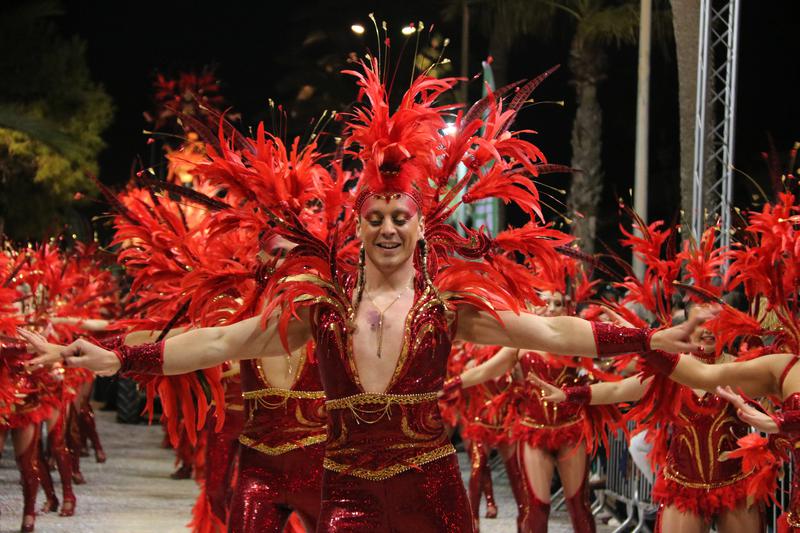Carnival 2024 in Catalonia: where and when to celebrate?
The week-long celebration includes food fights, dancing giants, traditional folk dances, colorful parades, and sardine burials all around Catalonia

The month of February in Catalonia is, true to tradition, the month of one of the longest celebrations of the year, the Carnaval or Carnestoltes in a handful of Catalan cities and towns.
This year, the carnival will kick off on Thursday, February 8, also known as Fat Thursday with the arrival of the Carnival King, King Carnestoltes, and it will last until the following Wednesday, February 14, or Ash Wednesday.
Check out the Catalan News guide below to make the most of these exhilarating festivities.
Thursday, February 8
‘Fat Thursday’ marks the beginning of the Catalan celebration and is the day when people are encouraged to indulge in fatty foods such as botifarra d'ou (egg sausage) and truita (omelet) or coca de llardons (pork crackling cake).
As far as festivities are concerned, Thursday is a good day to get your Carnival groove on. In Vilanova i la Geltrú, a coastal town south of Barcelona, there will be what locals call 'La Merengada' - a massive meringue food fight. Children (and more than a few adults) will gather at 5:30 pm in front of Blanch bakery on Avda. Francesc Macià, 43 to partake in the annual sticky dessert hurling ritual.
But due to the ongoing drought, this year’s food fight will be smaller than usual in order to save water when cleaning.
Later on in the evening, there will be 'Arribo' parades all over Catalonia as the king or queen of Carnestoltes "arrives" to take part in the fun. Sitges, directly north of Vilanova i la Geltrú on the Garraf coast, is famous for the parade, but Barcelona and other towns will have their own parades. Sitges' show starts at 7.24 pm exactly, while the Catalan capital's kicks off at 6:10 pm on La Rambla boulevard.
Friday, February 9
Towns like Vilanova i la Geltrú celebrate the 'Arribo' on Friday, not Thursday, as do several Barcelona's districts, some of which will have their own smaller parades, as Les Corts's festivities, which start at 5:00 pm at Plaça de Comas.
In Raval, the parade Ravalstoltada will start at 6:00 pm at the Rambla de Raval.
Friday in particular is a big deal for schoolchildren in Catalonia as it is a day they'll be sure to dress up for parades in their hometowns. This comes, of course, after a week of very specific attire at school: pajama day, mismatched socks day… you get the picture. It's also one of the nights you're most likely to see adults out in costume at a club or bar.
Saturday, February 10
On Saturday, several parades will take place all over Barcelona throughout the day.
In the Eixample district, the LGBTIQ+ collective’s parade will start at Pl. De Universitat square at 5:30 pm.
In the Gràcia district, the Carnival will be celebrated with a Carnefoc, a spin on the Correfoc tradition, where people dress up as demons and run through the streets with fireworks flying off them. The Carnefoc will start at Mare de Déu del Coll Street at 7:30 pm and will be followed by a pyrotechnical show at the Mare de Déu del Coll church at 9:00 pm.
Meanwhile, in Solsona, Carnival is done differently. On Saturday, the traditional 'mata-ruc' donkey-killing ceremony will take place. This, thankfully, is not as appalling as it sounds: it's only a fake donkey that's hung from the church bell tower, this year will be the 40th anniversary of the ceremony. The expression ‘mata-rucs’ was once used disparagingly about the residents of Solsona, but has now been reclaimed, and on Saturday, an ‘Honorary Mata-rucs’ will be proclaimed. Head to the very aptly named Plaça del Ruc square at 7:30 pm to witness this peculiar tradition.
Sunday, February 11
Sunday is a big day for parades as there is usually more than one in the same city or town on this day.
For those who didn't have enough with 'la merengada', there will also be a candy-throwing war known as 'la Comparsa' on Sunday in Vilanova i la Geltrú.
In the city of Sant Celoni, the traditional ‘Ball de Gitanos’ will take place on Sunday on the Plaça de la Vila square. The dance dates back to 1767, although it is pagan in origin and was traditionally performed in the Catalan Vallès region.
Monday, February 12
Monday is usually the day of rest after a weekend of Carnival madness, but this is not always the case! In Roses, a town on the Costa Brava, it's actually the last day of Carnival. Unlike the rest of Catalonia's sardine burials, Roses is on Monday. The town will also be hosting an 'arrossada popular' rice meal for the community.
Tuesday, February 13
In some places, such as Vidreres near Girona and Ponts near Lleida, Tuesday (‘Mardi Gras’ in much of the Carnival-celebrating world but Carnival Tuesday or 'Dimarts de Carnaval' here) is the day locals eat 'ranxo' soup, a special meat and vegetable stew made from the ingredients residents bring to the town square.
Don't miss Sitges' Extermination parade on Tuesday night, one of Catalonia's most popular Carnival processions. Beginning at 9 pm, expect to party all night.
Wednesday, February 13
Carnival comes to a close with the symbolic burial of the sardine ('enterrament de la sardina') on Ash Wednesday, or 'Dimecres de Cendra', as revelers put an end to the period of excess before Lent.
In the Catalan capital alone, Ciutat Vella, Sants-Montjuïc, Les Corts, Horta-Guinardó, Nou Barris, Sant Andreu, and Sant Martí will all be burying sardines - more than enough fish funerals for Barcelona residents and visitors to pick from!